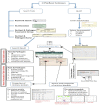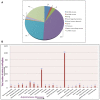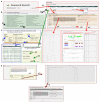miPepBase: A Database of Experimentally Verified Peptides Involved in Molecular Mimicry
- PMID: 29109711
- PMCID: PMC5660332
- DOI: 10.3389/fmicb.2017.02053
miPepBase: A Database of Experimentally Verified Peptides Involved in Molecular Mimicry
Abstract
Autoimmune diseases emerge due to several reasons, of which molecular mimicry i.e., similarity between the host's and pathogen's interacting peptides is an important reason. In the present study we have reported a database of only experimentally verified peptide sequences, which exhibit molecular mimicry. The database is named as miPepBase (Mimicry Peptide Database) and contains comprehensive information about mimicry proteins and peptides of both host (and model organism) and pathogen. It also provides information about physicochemical properties of protein and mimicry peptides, which might be helpful in predicting the nature of protein and optimization of protein expression. The miPepBase can be searched using a keyword or, by autoimmune disease(s) or by a combination of host and pathogen taxonomic group or their name. To facilitate the search of proteins and/or epitope in miPepBase, which is similar to the user's interest, BLAST search tool is also incorporated. miPepBase is an open access database and available at http://proteininformatics.org/mkumar/mipepbase.
Keywords: autoimmune disease; cross-reactivity; database; molecular mimicry; peptide.
Figures



Similar articles
-
ImitateDB: A database for domain and motif mimicry incorporating host and pathogen protein interactions.Amino Acids. 2022 Jun;54(6):923-934. doi: 10.1007/s00726-022-03163-3. Epub 2022 Apr 30. Amino Acids. 2022. PMID: 35487995 Free PMC article.
-
Using molecular-mimicry-inducing pathways of pathogens as novel drug targets.Drug Discov Today. 2019 Sep;24(9):1943-1952. doi: 10.1016/j.drudis.2018.10.010. Epub 2018 Oct 23. Drug Discov Today. 2019. PMID: 30366058 Review.
-
PlantAFP: a curated database of plant-origin antifungal peptides.Amino Acids. 2019 Nov;51(10-12):1561-1568. doi: 10.1007/s00726-019-02792-5. Epub 2019 Oct 14. Amino Acids. 2019. PMID: 31612325
-
HIPdb: a database of experimentally validated HIV inhibiting peptides.PLoS One. 2013;8(1):e54908. doi: 10.1371/journal.pone.0054908. Epub 2013 Jan 24. PLoS One. 2013. PMID: 23359817 Free PMC article.
-
Innate and adaptive immune requirements for induction of autoimmune demyelinating disease by molecular mimicry.Mol Immunol. 2004 Feb;40(14-15):1103-8. doi: 10.1016/j.molimm.2003.11.010. Mol Immunol. 2004. PMID: 15036915 Review.
Cited by
-
ImitateDB: A database for domain and motif mimicry incorporating host and pathogen protein interactions.Amino Acids. 2022 Jun;54(6):923-934. doi: 10.1007/s00726-022-03163-3. Epub 2022 Apr 30. Amino Acids. 2022. PMID: 35487995 Free PMC article.
-
Advancing therapeutic vaccines for chronic hepatitis B: Integrating reverse vaccinology and immunoinformatics.World J Hepatol. 2025 Jul 27;17(7):107620. doi: 10.4254/wjh.v17.i7.107620. World J Hepatol. 2025. PMID: 40747216 Free PMC article. Review.
-
Rapid improvement in Alzheimer's disease symptoms following fecal microbiota transplantation: a case report.J Int Med Res. 2020 Jun;48(6):300060520925930. doi: 10.1177/0300060520925930. J Int Med Res. 2020. PMID: 32600151 Free PMC article.
-
Investigating the eukaryotic host-like SLiMs in microbial mimitopes and their potential as novel drug targets for treating autoimmune diseases.Front Microbiol. 2022 Nov 4;13:1039188. doi: 10.3389/fmicb.2022.1039188. eCollection 2022. Front Microbiol. 2022. PMID: 36406429 Free PMC article. No abstract available.
-
Visiting Molecular Mimicry Once More: Pathogenicity, Virulence, and Autoimmunity.Microorganisms. 2023 Jun 1;11(6):1472. doi: 10.3390/microorganisms11061472. Microorganisms. 2023. PMID: 37374974 Free PMC article.
References
LinkOut - more resources
Full Text Sources
Other Literature Sources
Research Materials

